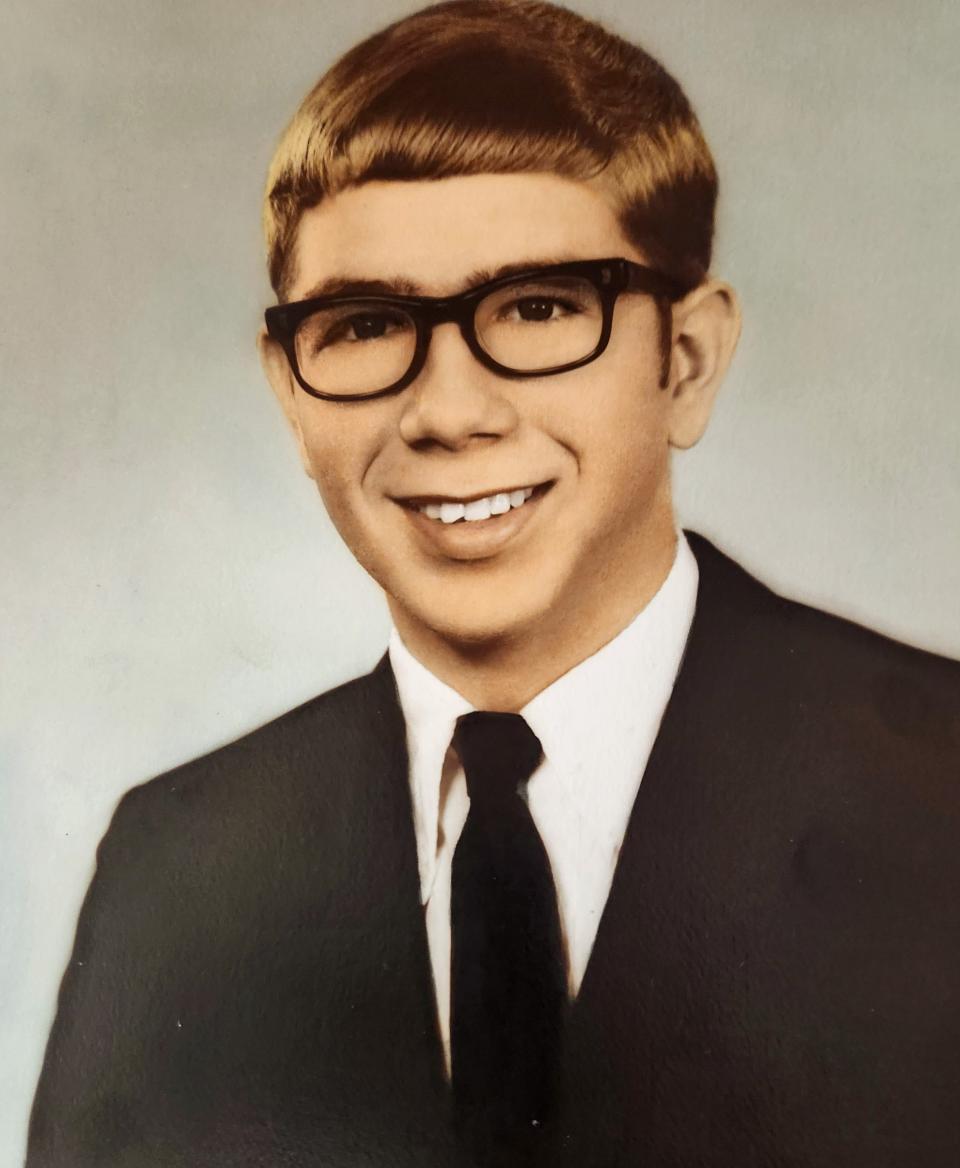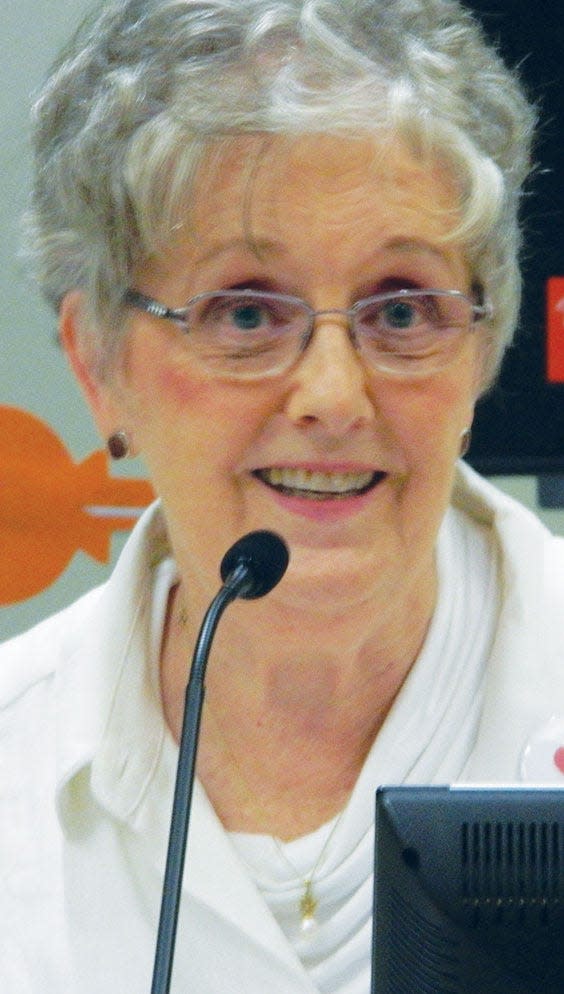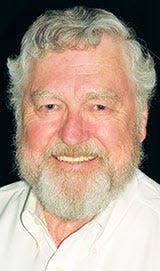The life of Bob Eby, Part 1
Retired Oak Ridge High School teacher Benita Albert brings us another story of a graduate of Oak Ridge Schools who has achieved a great deal in his life … even if he did get a rocky start when he was caught rolling a yard with toilet paper.

Here is how Benita told it to me when Bob Eby suggested I ask her about it. “A group of five of my wonderful, first-year students, including Bob, decided to roll my yard, but they bungled it and rolled a neighbor’s yard … the neighbor caught them, took down the license plate number for the car they were in and called the cops. The car was registered to a prominent medical doctor in town - all five boys were soon identified and required to report at 6 a.m. the next morning to remove all the paper. There is so much more to this story that I might tell this for the ORS stories on which I will speak at the next ORHPA meeting on April 13. I don’t plan to name names …”
So, to learn the rest of the story, plan to attend the Oak Ridge Heritage & Preservation Association’s membership and public meeting at 7 p.m. Thursday, in the Wildcat Den room at the Oak Ridge History Museum, 102 Robertsville Road.
Now enjoy Benita’s story on Bob Eby.
***
On March 15, Robert "Bob" Eby was sworn in as the chairman of the Tennessee State Board of Education. This appointment comes 53 years after he graduated from Oak Ridge High School and after many years of service to public education alongside a stellar professional career in engineering science and administration. Telling his story is a special honor for me, his former ORHS math teacher, who has benefitted from his advocacy and visionary leadership in education. He served four terms on the Oak Ridge Board of Education before receiving an appointment to the Tennessee Board of Education in 2018. More on his work with education will be discussed in the second part of his story. This Part One explores his Oak Ridge roots and education.
Bob’s father, Raimon Eby, was studying engineering at Colorado State University when he received a draft notice from the U.S. Army during World War II. His first military assignment was spent in specialized training at North Carolina State University as a part of the Special Engineering Detachment of the Army. That training was designed for his next, Oak Ridge Manhattan Project assignment in mass spectrometry at K-25. Bob’s mother, Rosemary, was a secretary at K-25. The couple first met at the Grove Center Bowling Alley. Raimon and Rosemary lived to see their first son, Bob, become K-25’s plant manager in the 1990s, certainly a point of great pride for them.
Bob has three siblings: Karen, deceased; and Bill, deceased (ORHS ’79); and Patti (ORHS Class of ’69). Patti is a retired court reporter in Greenville, SC. The Eby family were active members in Grace Lutheran Church. It was through a church-related weekend trip that Bob met Jean Gronstrom (ORHS Class of ’71).
Bob said, “I knew from the start that she was the one I wanted in my life.” They will be celebrating their 50th wedding anniversary in 2024.

Jean’s Oak Ridge heritage began when her parents Ann (from Alabama) and Al (from Rhode Island) met in Oak Ridge in 1942. Her father worked as a piping engineer at K-25. Her mother worked as a secretary for JA Jones (a construction contractor for the Manhattan Project) and later as a secretary in the Engineering Division under F.S. Patton. Bob recognizes Patton as one of his important professional mentors.
He recalled, “Pat inscribed and gave me a Bible that still sits on my desk, and he told me that if I lived by the principles of that book, I would do fine in my career. He was so right!”
Though Jean’s parents stayed in Oak Ridge, Bob’s parents left for a while.
Bob wrote: “Of all the places to decide to build a second gaseous diffusion plant, they (the government) chose Paducah. So, my dad volunteered to take his bride back (to her original hometown) and help start the plant in 1952. My Mom was five months pregnant with me, so I say ‘my roots are officially in Tennessee, but I was born in Kentucky.’ When I was twelve and starting seventh grade, my dad was transferred back to ORNL.”
Bob continued, “In the little town of Lone Oak, Ky., where I went to elementary school, I was one of the smartest kids in class. When I came to Oak Ridge, I found out totally different! Kids here were taking foreign language and band in elementary school. Oak Ridge Schools were well known! … I was put in some of the accelerated classes. I did not make A’s. It made me realize how important a good education is for the future.”
Bob began his Oak Ridge schooling at Robertsville Junior High. He had words of praise for English teacher Alice (Hughes) Miller and French teacher Gail (Waters) Clendenon whom he said were very encouraging to a young and overwhelmed transfer student.
At Oak Ridge High School, he named many key educators: Evelyn Armstrong in German, Benita Albert and Paul Smith in math, and the legendary Combined Studies team of Catherine Ledgerwood, Gene Pickel, Bill Countess, and Robert Moss. His love of science was enhanced in physics class with Jackie Jacoby, computer science with Barry Fernandez, and chemistry with Powell Puckett.
He said, “ORHS Chemistry gave me the basis for success in all my college honors chemistry.”
Puckett’s booming, "Great balls of fire" retorts resounded up and down the first floor of A-building, a response that Bob said could be provoked by a variety of student actions. Bob recalled that when students complained of the open classroom windows letting the cold air in, Puckett protested with a mini-lecture on heat transference, “Haven’t I taught you anything? Cold air doesn’t come in, hot air goes out.”
Spanish teacher Lloyd (Senor) Wattenbarger was the sponsor of the newly formed ORHS Bridge Club, and Bob was the first president. Though Bob never had Senor in class, he and good friend and bridge partner Jim Gillespie enjoyed the many hours Wattenbarger and Helen Dunigan, wife of ORHS Principal Tom Dunigan, devoted to teaching the club members, some of whom ultimately acquired master points in high school.
As for community activities, Bob stated that his involvement in Boy Scouts taught him about setting and achieving goals and leadership. He was an Eagle Scout and senior patrol leader in Troop 327. He and Jim Gillespie attended the Philmont Scout Ranch in 1967, an ultimate wilderness hiking adventure in the Rocky Mountains of northeastern New Mexico.
Bob was the first Fuller Brush salesman in Oak Ridge. His success influenced two ORHS friends, Tommy Rainey and Mike Kiser, to join the venture. He recalled the lucrative 40% commission they received that amounted to an average profit of $6-10 per hour. He enjoyed playing golf with his dad at the Oak Ridge Country Club, as well as earning a letter from the ORHS golf team.
Bob’s admiration for his father’s work influenced his educational future. His dad was recognized as the first person to observe and identify a previously unknown Californium isotope in his mass spectrometry lab at ORNL. The decision to major in chemical engineering offered Bob a compelling incentive. He could join the cooperative work/college engineering program and earn his way through college. Bob signed on as a co-op student at the University of Tennessee, where he alternated quarters of UT classwork with a year’s worth of work assignments at the Oak Ridge Gaseous Diffusion Plant (K-25) in the Development Division for Uranium Enrichment.
Bob described his experience: “The nice thing about the co-op program was that I was able to take night classes and graduate in 4.25 years. … I was able to get great working experience and also pay for my entire college career.” He added, “I was the first college graduate in our family.”
While at UT, Bob’s enterprising nature flourished.
He said, “Thanks to taking computer science from Barry Fernandez in high school, I was able to get a job while on campus.”
He described his initial job as ripping paper off the computer for students who were not allowed close access to equipment. He then advanced to consulting students in the introductory course, Math 3150 Fortran, and finally teaching the Math 3150 Lab during his senior year. He credits his ORHS computer science classmate, Mike Gilliam, for the key role he played in this appointment. (Note: There now have been many former ORHS computer science students who have been hired as undergraduates in the UT Computing Center - a fitting tribute to the ORHS computer science program.)
As Bob reflected on the above experience, he said, “Teaching that lab of college students always made me think that a perfect job might be a college professor. However, I never finished my Ph.D., and that is probably one of my life’s greatest disappointments. ... I did pass the required exams, and I still maintain my license as a professional chemical engineer registered in the State of Tennessee. I am proud of that accomplishment.”
Bob initiated graduate studies while also beginning full-time work at K-25 in August 1974. His first project was an assignment with ORNL colleagues in nuclear fuel reprocessing. Bob and his high school sweetheart, Jean Gronstrom, were married in June 1974. Jean earned a B.S. in Music Education from UT and accepted a job in the beginning band program at Linden School in the 1974-75 school year. Both Jean and Bob subsequently completed master’s degrees via UT night and extended studies programs. Bob’s graduate thesis, an offshoot of his work assignment at K-25, was “The Desublimation of Krypton from a Non-Condensable Carrier Gas Stream.” Bob laughed when recalling that his mother-in-law was surely overly impressed by his work. He said, “She thought of me as Superman. I had to explain to her that Krypton was not kryptonite.”
A variety of challenging assignments and professional opportunities ultimately got in the way of Bob’s coveted Ph.D.. Bob completed all the required coursework and had chosen to write a dissertation study on the development of an automatic control of a single engineering column that performed three functions: absorption, fractionation, and stripping. Though the dissertation was never written, it became a project for which he and his boss, Mike Stephenson, would later earn a patent. It was the first patent and one of three patents that Bob would eventually garner, the next two earned in the uranium processing field.
In 1984, Bob was selected by his employer, Martin Marietta, to attend the executive program at the Darden Business School of the University of Virginia, a summer-long program Bob described as a “mini-MBA.” The Eby family was growing with the arrival of Elizabeth in 1980 and William in 1983. Of this busy time in the 1980s, Bob wrote: “Family came, I got more involved in Oak Ridge School Board activities, and the family moved to California for my four-year assignment with Lawrence Livermore Labs beginning in 1986.”
Bob’s first election to the Oak Ridge Schools’ Board of Education was in June 1985, a four-year obligation that was interrupted one-and-a-half years later by his work reassignment in California. Thankfully, Bob returned to his Oak Ridge roots and to continued civic involvement with the Oak Ridge Schools as well as significant leadership roles in his professional work. More of this phase of his career journey and community service will follow in Part Two of his story including an inside perspective on his new role in the position of chairman of the Tennessee State Board of Education.
***
Thank you, Benita. I was glad to read that Bob attended the Darden Business School of the University of Virginia as I was fortunate enough to be sent to a leadership course there several years ago. A fine school and one that taught participative management, which I introduced to Y-12 as part of the Pride Circle program there several years ago. Brings back memories.
Be sure and look for Benita’s second and final part of her story about Bob Eby and learn more about what he is doing now in education at the state level.
D. Ray Smith is the Oak Ridge city historian. He writes a weekly "Historically Speaking" column for The Oak Ridger.

This article originally appeared on Oakridger: The life of Bob Eby, Part 1

